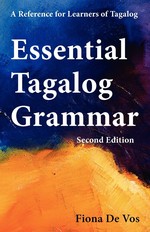Tagalog Verbs Used as Nouns and Their Objects
The object of a verb that is used as a noun (p. 85) may be expressed as a Ng phrase (p. 59) or a Sa phrase (p. 59). Examples:
|
ang kumain ng mangga |
the one who ate a/the mango |
|
ang kumain sa mangga |
the one who ate the mango |
|
ang kumain nito |
the one who ate this |
|
ang kumain dito |
the one who ate this (can also be understood as the one who ate here) |
Exception: If the object of a verb that is used as a noun is a personal name* or a personal pronoun, it can only be expressed as a Sa phrase.
|
ang nakakita’ kay Grace |
the one who saw Grace |
|
ang nakakita’ sa kanya |
the one who saw him/her |
* Personal names are names that refer to specific persons, animals, cartoon characters or anything with a personality.
See also:
- Ang personal pronouns (p. 44)
- Ng personal pronouns (p. 49)
- Sa personal pronouns (p. 53)
Please respect copyright. Learn more
Contents | Detailed Contents | Up ▲
See notes on Terminology and Pronunciation Marks
